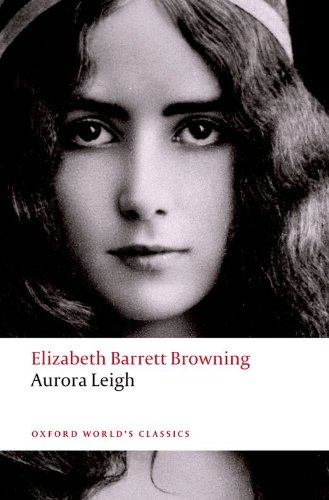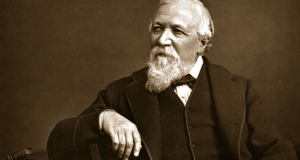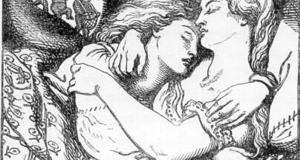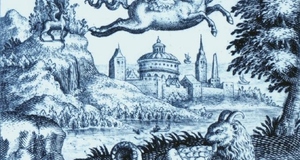Apocalyptic Imagery in Aurora Leigh
By
2015, Vol. 7 No. 03 | pg. 1/2 | »
KEYWORDS:
Elizabeth Barrett Browning’s Aurora Leigh (1856) is an apocalyptic work, as seen in Aurora and Romney’s vision of the New Jerusalem. Barrett Browning was interested in the Apocalypse in all its literary transformations for most of her adult life, as seen in many of her letters and poems. The English Romantics, also concerned with internal apocalypses, influenced both Barrett Browning’s poetry and her religious opinions, as did treatment of the Apocalypse and Christ’s second coming in religious works of the period. Such intellectual interest in a cataclysmic end of the world is evident in the structure, imagery, and themes of Aurora Leigh, Barrett Browning’s crowning literary achievement. A vision of the New Jerusalem ends the poem, but it is both a Christian and secular apocalypse that Aurora and Romney internalize. A definition of “apocalypse” is necessary to understand Barrett Browning’s views on the Apocalypse and her transmutation of those views in Aurora Leigh. The Christian Apocalypse of Revelation describes cataclysmic destruction, the end of the world, a new heaven and new earth, the marriage of Christ and his bride the church (New Jerusalem), the redemption of the elect and eternal damnation of the unsaved, and a promise of restoration and return. This apocalypse also contains a linear view of history: “a single … defined plot, with a beginning (the fiat of creation, a catastrophe (the fall of man), a crisis (the Incarnation and Resurrection of Christ), and a coming end (the abrupt Second Advent of Christ as King, followed by the replacement of the old world by ‘a new heaven and a new earth’)” (Abrams 343-44). Aurora Leigh contains a chronological beginning, middle, and end, so it appears to be a traditional apocalypse (Reynolds 28).The internalization of the Apocalypse flowered in English and German Romanticism, with roots in medieval theology (Abrams 358). Romantics viewed the Apocalypse of Revelation and Christ’s second coming as a “personal and internal experience” within the mind, instead of a literal end of the world (355). Reacting to revolutions in America and France, they “substituted an apocalypse of consciousness” for revelation and revolution: “the mind of man possesses the power . . . to transform his intellect and imagination, and by so doing to transform his perception of the everyday world into a new earth” (360). At the end of Aurora Leigh, Aurora and Romney invoke a vision of the New Jerusalem, but there is no cataclysmic destruction; instead of a traditional apocalypse, the poem describes an “apocalypse within” (353). As such, Aurora Leigh is a contradiction, for it is both a Christian and secular apocalypse. In the Apocalypse of Revelation, Jesus Christ ushers in the new heaven and new earth, rescues the elect, banishes the sinful to eternal damnation, and marries his bride the church. The secular apocalypse, however, is paved by “the philosophic, social, or poetic seer who demonstrates the way to a secular redemption” (Abrams 358). Although Aurora describes her poetic calling in social and prophetic imagery, with herself as seer (secular apocalypse), she and Romney realize that they must rely on God (Christian apocalypse) to save mankind: “First, God’s love. / And next . . . the love of wedded souls” (Browning IX.881-82). Aurora and Romney’s social mission, though not a literal and cataclysmic apocalypse, is still distinctly Christian. Apocalyptic readings of Aurora Leigh are few, with many critics instead interpreting the work from a feminist viewpoint.1 However, those who do discuss its apocalyptic nature emphasize the novel-poem. Simon Avery and Rebecca Stott discuss the influence of eighteenth-century philosopher Emmanuel Swedenborg on Barrett Browning’s religious views and her transmutation of those views in Aurora Leigh, but they read the poem as only a secular apocalypse. Martin Bidney sees Aurora Leigh as a series of apocalyptic epiphanies; however, his definition of “apocalypse” is neither Christian nor secular but a “turning [of] stones to fire,” e.g., epiphanies made up of ancient elements (5, 173). Ranen Omer places Aurora Leigh in historical and religious contexts but claims that Barrett Browning’s religious views are traditionally Christian. Yet before she died, Barrett Browning did not believe in a literal second coming, literal hell, or traditional apocalypse – opinions that influenced the secular nature of the apocalypse in Aurora Leigh. Dorothy Mermin merges feminist and apocalyptic readings of Aurora Leigh but discusses only the secular nature of Aurora and Romney’s vision of the New Jerusalem, with Aurora in the defining role of “the creation of a new social order” (183). However, the “apocalypse within” must be combined with the Apocalypse of Revelation to understand Aurora Leigh’s apocalyptic nature. Finally, Linda Lewis analyzes Barrett Browning’s religious growth and four-stage “quest,” including “the internalization of … Apocalypse (rejecting the doctrine of the end of the world in favor of . . . renovat[ing] and resurrect[ing] this present world)” (13). Although Barrett Browning embraced the Romantic concept of the “apocalypse of consciousness” (Abrams 360), she did not wholly abandon the Christian understanding of apocalypse. Barrett Browning had a lifelong interest in the Apocalypse and religious works on the subject, since she “read the Scriptures every day” (Kenyon, I, 159).2 She questioned intellectuals about their opinions on apocalyptic imagery in Revelation (Kelley and Hudson, II, 144)3 and was familiar with the work of Edward Irving, “Scottish founder of the Catholic Apostolic Church” – For the Oracles of God, Four Orations (1823)4 and his translation of Manuel Lacunza y Diaz’s The Coming of Messiah in Glory and Majesty (1827),5 both of which dealt with Christ’s Second Coming (Forster 49). Barrett Browning also said she “was born under the star Wormwood” (Karlin 88),6 a reference to an angel’s trumpet in Revelation (8:10-11), and used apocalyptic imagery because she believed she was making everyone feel bitter with her poetry. In 1841, she collaborated with Richard Henry Horne on Psyche Apocalypte (Forster 102-03). The proposed literary project “was to be a drama on the Greek model, treating of the birth and self-realisation of the soul of man,” but it did not come to fruition (109; Kenyon, I, 84-5). Finally, Barrett Browning was interested in spiritualism and the supernatural, unlike her father and husband (Forster 279-81). She did not believe the visions of Harriet Martineau, a journalist and mystic allegedly “cured of cancer by mesmerism,” were real (131-32). She still she noted how far others could be carried away in their beliefs: “There is even now a religious sect at Cheltenham, of persons who call themselves advocates of the ‘third revelation’” (Kenyon, I, 219).7 Whether Barrett Browning believed in a literal Second Coming or New Jerusalem is unclear. Her religious views changed over time. She told her husband Robert, one year before they married in 1846, that “sometimes . . . I have haste to be done with it all” (Karlin 87).8 Did she desire to be finished with poetry or with life, i.e. expectation of a literal Second Coming? Later, one year before Aurora Leigh was published in 1856, Barrett Browning told a family friend about her apocalyptic views, saying that she did not believe “the battle of Armageddon could ever signify anything but a great spiritual strife. The terms . . . are plainly to my mind symbolical” (Forster 64, 70; Kenyon, II, 194).9 She also wondered “whether Christ’s ‘second coming’ will be personal. The end of the world is probably the end of a dispensation” (Kenyon 194). Instead of cataclysmic destruction, Barrett Browning “expect[ed] . . . a great development of Christianity in opposition to the churches, and of humanity generally in opposition to the nations” (194). This view is not biblical but symbolic, an apocalypse within: “We are entering on a Reformation far more interior than Luther’s” (426).10 In Aurora Leigh, however, this apocalypse is still Christian, for it needs divine intervention to take place. Barrett Browning’s opinions on resurrection were more traditional and a subject of great interest to her: “Among all the ways of progress along which the minds of men are moving, this draws me most” (Kenyon, II, 289).11 When she “speak[s] of ‘old cerements’ being put off, I pre-suppose a living body in resurrection” (426).12 Barrett Browning sees marriage not as “an old cerement” but as an intimate part of the resurrection (426). In her mind, it is a critical element of the Apocalypse, whether literal (marriage supper of the Lamb) or symbolic (marriage of Aurora and Romney). Writing to Madame Braun, Barrett Browning says, “There is in the world now . . . scientific proof that what we call death is a mere change of circumstances, a change of dress, a mere breaking of the outside shell and husk” (289).13 This view of resurrection is symbolic. Where did such a lifelong interest in the Apocalypse originate? Barrett Browning is a Victorian writer, having composed and published most of her work in the first half of Queen Victoria’s reign. However, her “formative reading years fell circa 1816-1830,” the height of Romanticism (Reynolds 12). Barrett Browning was a great lover of Romantic poetry, having read by age sixteen much of Wordsworth, Keats, Byron, and Shelley; she “was influenced by all of them” (Forster 28). She was also familiar with the work of Maria Edgeworth, Sir Walter Scott, Mary Wollstonecraft, and Madame de Stael (Forster 18, 29, 67). So although Barrett Browning was a Victorian poet, her literary and intellectual interest was in Romanticism. She became interested in the Apocalypse through the Romantics, as seen in Wordsworth’s Prelude (1850) and her own Casa Guidi Windows, Poems Before Congress, and Aurora Leigh. Barrett Browning acquired from these Romantic poets “the notions of (divine) inspiration . . . the role of the poet as a prophet for the time,” and “the imperatives of the poet’s task as mediator between God and man” (Reynolds 13). Aurora Leigh as poet embodies these roles. Another influence on Barrett Browning’s intellectual interest in the Apocalypse was Emmanuel Swedenborg, an “eighteenth-century Swedish philosopher and mystic” who is credited with many spiritual truths in Aurora Leigh (Avery and Stott 135). Blake and Coleridge were influenced by his writings, as were Balzac, Baudelaire, Emerson, and Yeats (135). Barrett Browning was familiar with Swedenborg’s The Apocalypse Revealed and Heaven and Hell (1758); the former posits “that the New Jerusalem is a ‘New Church’ on earth,” from which she formulated the idea of “the end of the world” as an “end of a dispensation”14 (Lewis 89). Barrett Browning’s belief “in what has been called a ‘correspondence’ between the natural world and the spiritual” (Kenyon, II, 300) is a Swedenborgian concept that appears in Aurora Leigh (Avery and Stott 136). Aurora believes that “unless the artist keep up open roads / Betwixt the seen and unseen” (II. 468-69), all socialist programs will fail. Regarding the Apocalypse, Swedenborg believed that Christ’s “Second Coming would” take place through “an intellectual and spiritual revolution,” i.e. “his own writings” (Avery and Stott 137). These Swedenborgian ideas on the symbolic, internal nature of the Apocalypse come to fruition in Aurora Leigh. Many of Barrett Browning’s early poems allude to the Apocalypse. In “The Tempest,” the speaker describes a cataclysmic storm: “O Death – O crowned Death – pale-steeded Death!” (63),15 a reference to the fourth seal of the Apocalypse (Revelation 6:7-8). In “Earth,” the natural beauty of Earth is destroyed in the Apocalypse. The speaker hears ... the hereafter cry, Finally, in “Sounds,” the speaker describes God communing with the soul “using the supreme voice which doth confound / All life with consciousness of Deity, / . . . As the seer-saint of Patmos, loving John . . . turned to see / The voice which spake.”18 In these short poems, written before she was thirty, Barrett Browning demonstrates her thorough knowledge of the Apocalypse and her belief in a literal Second Coming that was not sustained in her later poetry. Barrett Browning’s political poems Casa Guidi Windows (1851) and Poems Before Congress (1860) also use apocalyptic imagery. Windows “contains the impressions of the writer upon the events in Tuscany of which she was a witness” – the revolutions of 1848 and 1851 in Florence, Italy (Poetical Works 340). Describing an apocalypse by revolution, Barrett Browning mentions Savonarola, whose death “cowl . . . turned to wormwood bitterness19 the wide / Deep sea of his ambitions” (ll. 273-75); his followers’ desire is to “plant the great Hereafter in this now” (l. 299). However, the leaders realize that revolution is not the answer, so “the people must be revived from within,” which is Aurora and Romney’s joint mission in Aurora Leigh (Lewis 110). In the Congress poem “Italy and the World,” Italy’s cities are “graves reserved by God, in a / Day of judgement . . . till the new earth and heaven [are] made ready!” (ll. 1-2, 10) The speaker envisions “newly created / Beautiful Italy” undergoing an apocalyptic revolution, wherein “the trumpet sounded [and] the graves were opened”20 (ll. 25, 32-33). Italy, a symbolic new heaven and new earth, brings to the world “one confederate brotherhood . . . to mark the advance of all humanity” (ll. 48-50). The speaker imagines Italy’s apocalyptic calling to the nations as an end to cheap nationalism, patriotism, and self-love. In these poems, Barrett Browning “argues that . . . the Apocalypse means bringing the ‘Great Hereafter’ to this present, political world” (Lewis 14). An apocalypse within is the answer, as seen in Aurora Leigh. Aurora Leigh’s structural affinities to the Apocalypse are many, including its conception of history as both linear and circular. Like Revelation, the work has a conventional beginning (birth and childhood), middle (London and Italy), and end (marriage to Romney). However, Revelation also contains “circular . . . movement from a unitary felicity, through self-division, sin, exile, and suffering, back to the initial felicity” (Abrams 346-47). Aurora Leigh is likewise a cycle, for the plot structure of the last four books repeat the first four in reverse (Cooper 153-54). Books 1 and 9 describe a wedding; books 2 and 8 “record Romney’s proposal,” “Aurora’s rejection,” and their “reinterpretation of that day”; books 3 and 7 describe Marian’s “attempted and actual rape”; and books 4 and 6 discuss her “abortive wedding” (154). Therefore, Aurora Leigh is a Victorian reinterpretation of the Christian Apocalypse. In the new heaven and new earth of Revelation, the consummation of the Apocalypse is a wedding between Christ and his bride the church. Although wedding imagery abounds in Aurora Leigh, two weddings never take place.21 In the first, Aurora’s English father meets her Italian mother in a church, in a procession of “white-veiled rose-crowned maidens holding up / Tall tapers . . . / And letting drop the white wax as they went / To eat the bishop’s wafer at the church” (I.81-82, 84-85). Her mother symbolically jilted Christ for the love of her father. However, Marian’s jilting of Romney at the altar ends in an apocalyptic tone: “From end to end, the church / Rocked round us like the sea in storm, and then / Broke up like the earth in earthquake,”22 as parishioners and wedding guests attack Romney for believing he has hidden or injured Marian (IV.858-60). With such images of dire cataclysm, this second wedding cannot succeed because of Romney’s motives. The result of the failed wedding is “a screen of carven ivory / That shuts the heavens’ conventual secrets up / From mortals over-bold” (IV.992-94). With no apocalyptic renewal, as a type of Christ Romney must try again. Unlike these first two weddings, Aurora and Romney’s marriage at the end of the poem is successful. They invoke the New Jerusalem, wherein blind Romney “sees” “laid in jasper-stone as clear as glass / The first foundations of that new, near Day / Which should be builded out of heaven to God” (IX.955-57). Their “vision” recalls that of John of Patmos, who sees “Jerusalem coming down out of heaven from God . . . like a jasper, clear as crystal” (Revelation 21:10-11). Therefore, Aurora both sees and builds this New Jerusalem: “Jasper first . . . / And second, sapphire; third, chalcedony; / The rest in order – last, an amethyst” (IX. 962-64), four of the precious stones used for “the foundations of the city walls” of the New Jerusalem (Revelation 21:19-21). Aurora and Romney believe they have symbolically created a new heaven and new earth by their holy union, for Aurora is to continue her calling as a poet and prophet of her times. It is not a literal apocalypse, since the world does not end in cataclysmic destruction with their marriage; the emphasis is on redemption and renewal. Paradoxically, this apocalypse does not taken place in the poem. Romney says that “the old world waits the time to be renewed,” in which “shall grow spontaneously / New churches, new oeconomies, new laws / Admitting freedom, new societies / Excluding falsehood: HE shall make all new”23 (IX.942, 946-49). Such a renewal of earthly society must wait for both Romney and Aurora’s wedding and the New Jerusalem; although the foundations have been laid, the city and its walls cannot be completed until Aurora resumes writing poetry, which she had put aside. Earthly societies will not be restored with their wedding, for the apocalypse must occur within, one person at a time. Their future wedding has allowed them to see the vision, but they must now respond to that vision, an action that does not occur in the poem.Continued on Next Page » Suggested Reading from Inquiries Journal
Inquiries Journal provides undergraduate and graduate students around the world a platform for the wide dissemination of academic work over a range of core disciplines. Representing the work of students from hundreds of institutions around the globe, Inquiries Journal's large database of academic articles is completely free. Learn more | Blog | Submit Latest in Literature |

















